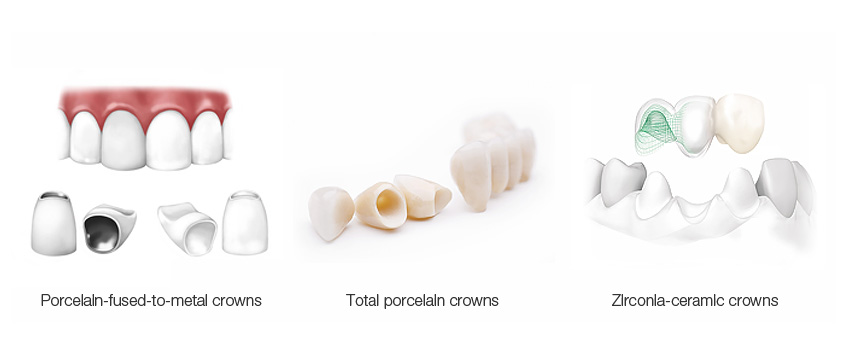Dental crowns are the most common prosthetic solution in case of a functional or aesthetical tooth damage. They are made of ceramics which imitates the colour of the tooth well, and the crown protects the tooth from further damaging in order to prevent possible tooth decay. The crown may also correct the appearance and the colour of the tooth with the aim of returning a nice natural smile and getting back self-confidence.
About the procedure
Dental crown (caps) is a prosthetic implant which replaces the tooth when natural teeth are damaged to such an extent that the fillings cannot cover the lost part. Crowns are recommended for recovering the functionality of the tooth in case of a more serious decay of the natural tooth due to a significant caries. It is also recommended for endodontic treated teeth that are usually greatly damaged after the treatment and should be protected.
Ceramics (or porcelain teeth, porcelain covers) has become the gold standard in dental prosthetics because of a number of good properties that other materials do not satisfied. It is characterized by high strength, and can withstand high temperature changes, while it is also resistant to chemical influences such as corrosion. Most importantly, it is biocompatible and does not cause allergies but at the same time it aesthetically mimics the appearance of real teeth.
How is ceramic crown placed?
Before placing the crown to natural teeth, it is necessary to prepare the tooth first in order to safely cement the dental crown. Very precise impressions of teeth and surrounding tissues are molded, and are sent to a dental laboratory for production. On next visit to our Polyclinic, the crown is cemented on the tooth, and adapted to the tooth to be comfortable in the mouth.
It entirely covers the tooth crown – the visible part of the tooth in the mouth. Dental crown is also inserted on dental implants in order to completely replace the missing tooth in its shape, size and firmness. It replaces the natural tooth surface and brings back a beautiful and natural smile.Permanent dental crowns can be made of porcelain-fused-to-metal, all-ceramic and zirconia-ceramic.
How long does the ceramic crowns last?
Lifetime of a ceramic crown is difficult to predict because it depends on oral hygiene of a person. The crown alone can not get cavities, but the tooth below can. With good hygiene and regular control, it can last from 10 to 20 years. Habits like nail-biting, ice-biting or night crunch significantly shortens durancy.
These photographs show the real condition before and after the procedure. The results of each procedure are subject to individualities and normal variability of surgical results. Consequently, Bagatin Clinic cannot guarantee equal results for each individual client.
TYPES OF DENTAL CROWNS
1. Porcelain-fused-to-metal crowns
The base of the crown is made of a metal alloy and is completely covered in porcelain, making the metal part invisible. Metals used for the preparation of porcelain-fused-to-metal crowns are gold alloys, other metal alloys (e.g. palladium, titanium) or steel-based alloys (e.g. nickel or chrome). The advantages of porcelain-fused-to-metal crowns is that they are more resistant to cracking and breaking. Also, due to their firmness and consistency, they are often used for covering the molars and to withstand the strong bite forces. White gold is a biocompatible material and thus recommended to clients allergic to metal. The metal base is completely covered by porcelain to preserve the tooth aesthetics.
2. Total porcelain crowns
All-ceramic, i.e. porcelain crowns meet high aesthetic requirements of the clients. Porcelain crowns completely mimic the optical properties of natural teeth, such as translucence, transparency and luminescence which are entirely transferred into ceramics, resulting in a dental crown which is impossible to differ from a natural tooth. Moreover, since it is metal free, it does not influence the gum colour change nor does metal shine through the teeth. All-ceramic crowns are recommended for front teeth in order to preserve their high level of aesthetics. Such crowns are very complex and depend on anatomic characteristics of the client and thus not applicable in all cases.
3. Zirconia-ceramic crowns
Zirconia is the newest high-quality material used for the preparation of dental crowns and bridges. Zirconia-ceramic crowns and bridges are five time stronger than the porcelain ones, they are biocompatible and precise, and preserve the natural tooth aesthetics. Taking into account that the mechanical resistance is already achieved at the thickness of 0.4mm, this requires less grinding of the natural tooth before inserting the crown. Due to a precise preparation of zirconia-ceramic crowns, oral hygiene is easier, and gum irritation is minimal (thanks high level of polishing and precision of the crown margins). White colour of zirconia is a base, which gives the natural colour even to smaller teeth. The advantage of these crowns is that there is no “black edge” caused by gum recession because there is no metal in the construction.
Am I a candidate?
Dental crowns are used for many reasons. People with one or more dental implants certainly need dental crowns to be built on the implant in order to successfully replace the lost tooth. Crowns are also recommended for the people who have an extensive tooth caries, which is hard to cover and fix the tooth with a large filling, and also for people after the endodontic treatment in order to protect severely damaged teeth in order to preserve them.
How do you prepare?
During the consultation, our doctors of dental medicine will define your wishes and goals. During your visit to our clinic, you will undergo a complete examination of the teeth and gums with the help of 3D X-rays imaging to determine the current state of oral health condition, after which we will create for you a treatment plan. Before placing the crown, tooth should be reduced and polished from all sides to prepare it for the crown. The amount of tooth that needs to be removed depends on the type of crown that is used.
During the procedure
It is necessary to define wishes and objectives during the consultations, through the conversation with the dentist. The consultation starts with a complete teeth and gum examination, using a radiographic image in order to determine the actual oral health condition, as well as the condition of the dental root and the surrounding bone. Before placing the crown, it is necessary to reduce and grind the tooth on all sides to make place for the crown to fill in. The amount of tooth to be removed depends on the type of the crown. If the majority of the tooth is missing due to caries, it is necessary to replace one part of the teeth with a filling in order to enable easier and safer placement of the crown. After shaping the tooth, the impression of a tooth is taken and, based on it, an adequate crown is prepared in the laboratory, taking care that the colour of the crown matches the surrounding teeth in order to achieve as natural look of the teeth as possible. Until the permanent crown is placed, a temporary crown is made to protect the prepared tooth. Before placing the crown, the dentist checks whether the prepared crown is matching in colour and shape. After the check-up, the crown is permanently cemented and the margins of the crown are additionally polished, making an invisible joint with the tooth.
Free online consultation with our doctors
Send enquiryFeel free to contact us
By phone on +385 1 46 10 225 or through our online contact form
Send enquiry
Locations
| Green Gold Tower Ul. Grada Vukovara 269a/10, 10000 Zagreb |
|
| Donji grad Frana Folnegovića 1c/1, 10000 Zagreb |
|
| Dioklecijan Hotel & Residence Kranjčevićeva 45/1, 21000 Split |
Where to park
| Parking available in Green Gold centre, Zagreb underground garage. For detailed information download a map |

















